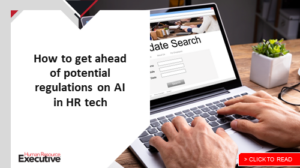Employers will often say their employees are their greatest asset, but in reality, they’re the one thing they typically know the least about. Too many employers don’t really know their employees, and it’s contributing to several overlapping phenomena in the labor market. While the Great Resignation is beginning to cool down, workers are still quitting their jobs at rates higher than those seen before the pandemic. As a result, employers are working vigorously to fill positions as employee turnover continues to skyrocket nationally.
Turnover is a deeper and further-reaching problem than it may seem. It’s not only disruptive to workplace culture and workflow across teams, but it’s incredibly costly. Studies show replacing a salaried employee costs a company six to nine months of that employee’s salary, on average.
At their core, these are all data problems within human resource departments. Between recruitment data, professional development data, performance data, turnover and retention data, compensation data, demographics data and benefits data, HR leaders are working with a ton of information about their employees, and it is all spread across different systems. In most cases, they have lots of data, but no ability to see it—and their employees—clearly.
Simply put, they don’t have the time or resources to make their data work for their organization. HR leaders are understaffed and overworked and, while they’re tasked with drawing insights, most aren’t equipped—nor do they have the professional background—to do data visualization and data analysis well.
In other places, there isn’t nearly enough data (or, enough quality data) to turn people insights into action. When it comes to drawing conclusions, getting budget and buy-in, and supporting vision, mission and strategy, HR teams are not as grounded in data science as they should be. But many are getting there.
See also: What HR gets wrong when it comes to using EX data
As an industry, HR is in the midst of a data renaissance. In 2019, over 70% of companies placed “people analytics” as a high priority. That majority has only grown since the COVID-19 pandemic. In order to be the strategic arm of their respective organizations, just like any other department, HR teams are learning to use data analytics to proactively identify needs and issues before they become big, costly problems—or missed opportunities.
You can’t know where you’re going until you know where you are
For too many HR departments, the ability to set, achieve and surpass diversity, equity and inclusion goals is one of those missed opportunities. Research from early 2022 found only 40% of organizations have conducted DEI-specific surveys. Without the demographic and experiential data from those surveys, HR teams leading DEI initiatives are doing so blindly. Without data, DEI initiatives cannot lead to sustainable action and cannot be scalable.
But there’s an even greater risk: When DEI initiatives do not produce results, HR teams risk damaging not only employee morale but public image. When employee data is scattered across multiple systems, or outright incomplete, making your hiring strategies and workplace initiatives data-driven is nigh-on impossible. Before making hiring promises, employers need to ensure they’re able to competently fulfill them.
Most HR teams are being held back by inaccurate or inconclusive data on employees, leaving them out of touch with the culture and needs of staff. Instead of “Black, Asian or Latino,” 60% of forms may say “N/A.” How can you act on DEI initiatives when you’re missing critical data on nearly two-thirds of your workforce? Without this data, you can’t look at racial and ethnic pay gaps, gender pay gaps, promotions and recognition across demographics.
Related: Why people data analytics is poised to drive big change in 2023
If an employer’s goal is to hire more women and people of color in engineering roles, for example, they’ll need to know how many women and people of color they currently have in engineering roles. As obvious as this may seem, too many HR teams are operating without the most basic information needed to achieve their DEI goals.
 While this data gap casts a dark cloud over the HR industry, there is a silver lining. HR leaders are beginning to understand the need for high-quality data—and more importantly, the need to bring all of that data into one place. HR data can provide crucial insights that can improve workforce decision-making, improve culture and morale, and optimize hiring and retention strategies today—and tomorrow.
While this data gap casts a dark cloud over the HR industry, there is a silver lining. HR leaders are beginning to understand the need for high-quality data—and more importantly, the need to bring all of that data into one place. HR data can provide crucial insights that can improve workforce decision-making, improve culture and morale, and optimize hiring and retention strategies today—and tomorrow.
By pinning their strategy to data interoperability, HR teams can become proactive rather than play catch-up indefinitely. Data-savvy HR teams should be able to aggregate and analyze their data to identify points of friction before they become points of fracture.
With well-kept employee records, HR teams can get granular and strategic about retention, and leverage insights to determine where turnover is most persistent. If turnover is most prevalent among women in the marketing department, for example, HR teams will have the ability to better identify and address root causes. Armed with data, employers can get ahead of problems like workplace toxicity, poaching and misalignment between roles and their advertised descriptions.
At the core of the movement toward “data-driven HR” and a re-grounding of HR in data science is a base—yet critical—need for HR teams to consistently collect, manage and organize their information. As HR’s data renaissance continues, HR teams will need to embrace analytics and make a concentrated effort to turn insight into impact.



